by Christie Purifoy | May 3, 2014 | Books, children, Food, Gardening, Spring, Uncategorized
Let’s all spread a blanket on some fresh spring grass and read a book, shall we?
Not sure what to read? Let’s see if I can help you with that. Not only am I recommending a few of my favorite recent reads (books with this season very much in mind), but I am GIVING AWAY FREE BOOKS.
Do I have your attention? Read to the end for all the details. And, as always, remember that I use affiliate links in each new edition of These Farmhouse Bookshelves. You can find more information about that right here.
*
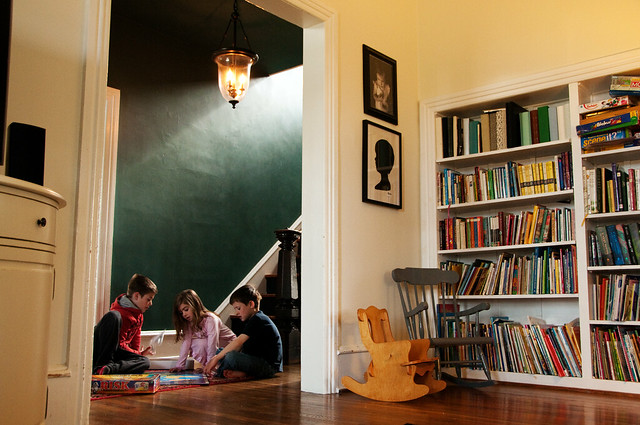
*
Recently, my sister Kelli sent us this first book as a gift (yes, the same sister of photography fame). It’s a picture book, but it was pretty much my lifeline during those last few horribly brown pre-spring days. The kids love it, too.
And Then It’s Spring (Booklist Editor’s Choice. Books for Youth (Awards)) by Julie Fogliano and illustrated by Erin Stead is a gorgeous, award-winning, treasure of a book. I recommend it for kids and for any big people in your life who love spring or gardening or quietly humorous storytelling.
by Julie Fogliano and illustrated by Erin Stead is a gorgeous, award-winning, treasure of a book. I recommend it for kids and for any big people in your life who love spring or gardening or quietly humorous storytelling.
This is a far cry from captain-underpants and diary-of-a-wimpy-kid humor, but it had my own kids howling. And then breathing very quietly and asking questions about the seasons and how plants grow. So, pretty much a winner.
… it is still brown, but a hopeful, very possible sort of brown … – Julie Fogliano
I discovered this next writer, and her debut book, at the recent Festival of Faith and Writing at Calvin College in Grand Rapids, MI. This book may have been the very best thing about that festival (though I hesitate to quantify an experience that was full to overflowing with Very Good Things).
Things That Are by Amy Leach is not like anything you have ever read. I promise you that.
by Amy Leach is not like anything you have ever read. I promise you that.
First, it is a beautiful book. Lovely to hold and with elegant, whimsical illustrations. A book-lover’s book.
Second, the writing is startling. Every single word is surprising and unanticipated. Hilarious and wise. Leach makes me laugh out loud and reminds me of the power words have to stab me straight through the heart. This book is a marvel.
What is it, exactly? It’s like a cross between a PBS nature documentary and Lewis Carroll. Except, so much better. So much wiser. Leach writes about nature – everything from panda bears and sea cucumbers to caterpillars and pea vines. She isn’t writing about people, except that she is. This is a book about the beautiful strangeness of our world and how much we can learn by taking a very close look at the creatures all around us.
Things That Are stretches the English language to its most delightful limits. This is nature writing as poetry, and each essay deserves to be read out loud.
Haywire personalities like peas, wobbly personalities with loose ends, iffy ends, result not from having no aim, no object in life, but from having an extrasensory object. What they want is beyond their powers of apprehension – until they hold it in their acute green wisps- so their manner is vagabond. The personality that longs only for perceptible things is down-to-earth, like a dung eater. But the teetery-pea kind send out aerial filaments to hound the yonder, tending every which way, guessing themselves into arabesques, for they are fixed on the imperceptible. – Amy Leach
Amy Leach sat right next to Fred Bahnson for one of my favorite panel presentations of the festival. I am also recommending his book Soil and Sacrament: A Spiritual Memoir of Food and Faith . If you enjoyed Barbara Kingsolver’s Animal, Vegetable, Miracle: A Year of Food Life
. If you enjoyed Barbara Kingsolver’s Animal, Vegetable, Miracle: A Year of Food Life then I’m sure you will appreciate Bahnson’s own memoir which explores the spiritual dimensions of the same subject (and if you haven’t read Kingsolver’s book please do go and rectify that).
then I’m sure you will appreciate Bahnson’s own memoir which explores the spiritual dimensions of the same subject (and if you haven’t read Kingsolver’s book please do go and rectify that).
In Bahnson’s words, this book is written from the perspective of a “pilgrim” and an “immersion journalist.” He tells his own stories, but he tells the stories of many others around the world who have discovered the sacredness of the dirt under our feet. This is a diverse bunch. There are mushroom-cultivating monks, metal-head, ex-con coffee roasters, maiz-growers in Mexico and Honduras, Pentecostal farmers, and Jewish growers of organic vegetables.
Gardeners and foodies will automatically appreciate this book, but I think it deserves a much wider audience. This book is also for all those interested in peacemaking and justice.
Beyond even that, this is a book about our spiritual origins. As Bahnson describes so eloquently, one of humanity’s oldest stories tells us something about ourselves that remains vitally important: we are the Adam who was created from the adamah. We are humans made of humus. Our spiritual and physical lives depend on the soil too many of us find it easy to ignore and abuse.
Our ecological problems are a result of having forgotten who we are – soil people, inspired by the breath of God. – Fred Bahnson
Now, on to the details you’ve been waiting for … free books.
The first giveaway is straight from me to you. I want to say thank you for reading these book recommendation posts, for sharing your own recommendations with me, and for clicking on those amazon affiliate links!
Also, I love Amy Leach’s book so much I want to share it with one of you. Leave a comment on this post, and you are automatically entered to win a copy. It will be very professional and unbiased and probably involve names in a hat.
The second giveaway is courtesy of Moody Publishers and my fellow writer Hannah Anderson. I’ve appreciated Hannah’s contributions at Pick Your Portion (we are both regular contributors there), and she has just written an eloquent and important book.
Conversations about women, the church, and identity tend to focus on roles or categories or accomplishments. I happen to think that those are very important topics of debate, and I love the books that shine new light on old conversations. But Anderson sets up camp somewhere else entirely, and we need that too. Made for More: An Invitation to Live in God’s Image explores a woman’s identity as first a person and an image bearer of a glorious God.
explores a woman’s identity as first a person and an image bearer of a glorious God.
This is an inspiring, encouraging, beautifully written book. Again, leave a comment on this post, and I’ll stick your name in the hat for a chance to win your own copy.
I’ll leave comments open for a week. Leave your comment before Friday, May 9 at 11:59 pm.
Good luck and happy reading!
by Christie Purifoy | Apr 29, 2014 | Desire, Dreams, Easter, Family, Food, Lent, Seasons, Spring, Stories, Uncategorized, Winter
Our Easter feast began the day before, on Saturday morning. One hundred or so neighbors. Two thousand or so eggs. Warm sunshine and hot coffee. Conversation and sticky children.
Or maybe it began earlier that week. When my sister and her four children tumbled, along with the crayons and crumpled napkins, from their minivan. A three-day road trip from Florida suddenly ended.
It is Easter, and we have feasted. On cousins sprouting like weeds and epic games of Monopoly. On baby chickens discovering bugs and grass and baby lettuces discovering rain.
We have feasted on hard-boiled eggs turned somewhat unappetizing shades of blue and my mother’s recipe for Greek chicken.
But mostly, we have feasted on time. On moments stretching into days spent at the table side-by-side with family.
***
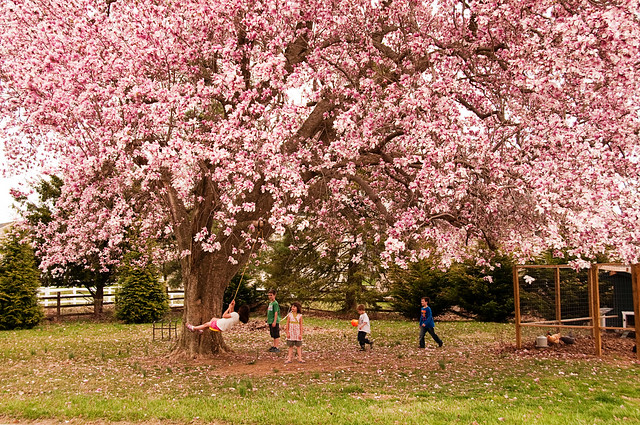
***
Family, for us, has always been feast or famine. Separated by miles, our mailing addresses like stars in a far-flung constellation, we do not relate casually. There is no dropping by. No Sunday lunches then home again. No Christmas gifts delivered in person. No grandparents to babysit for date night.
We have only not enough (telephone calls and emails) or too much (three daily cycles of the dishwasher and four of laundry just to keep the show running).
We know Lenten hunger, and we know Easter fullness.
***
Feast days leave little space for story-making. Not storytelling. There is time for that as we sit at table. Storytelling is a necessary part of celebration.
But story-making is born of hunger rather than plenty. It is our longing that reveals the contours of new dreams and new stories. Because we hunger, because we do not have, because we suffer, we search for meaning like desperate sailors search for land.
We search for cool blue in desert wastes. We search for Kelly green in stubborn snow.
In winter, we toss in our sleep, and we dream of spring.
In spring, we sleep dreamlessly and wake refreshed.
***

***
“For everyone who asks receives; the one who seeks finds; and to the one who knocks, the door will be opened.”
Matthew 7:8
by Christie Purifoy | Jan 18, 2014 | Books, children, Food, Uncategorized
Last weekend, on facebook, I promised you a peek at the bookshelves in my kitchen.
That’s right, I said, BOOKSHELVES IN MY KITCHEN.
Yes, I have all-caps feelings about the bookshelves in my kitchen. I don’t care all that much about granite countertops or stainlesss steel appliances, but I love having a built-in bookcase for my cookbooks.
Here are three of the books I reach for most often in that room … (p.s. you can see an actual glimpse of my kitchen bookshelves on instagram).

The Homemade Pantry: 101 Foods You Can Stop Buying and Start Making by Alana Chernila is my kind of cookbook. Lovely, big photographs, fun personal introductions before each recipe, everything tasty, nothing too hard.
by Alana Chernila is my kind of cookbook. Lovely, big photographs, fun personal introductions before each recipe, everything tasty, nothing too hard.
Plus, it’s inspiring, never shaming. This isn’t a book to make you feel guilty for buying your sandwich bread. More a book that nudges you to say, “Why wouldn’t I at least try making this if it tastes so good and takes so little extra time?”
At least, that’s the voice I hear as I flip these pages.
Also, despite what you might imagine after reading the subtitle, these are not gimicky recipes. This is good, basic, family food: yes, there are recipes for chocolate peanut butter cups and toaster pastries, but there are also crackers, pasta sauce, and breads. You can learn how (and why) to make your own applesauce, yogurt, and canned tomatoes. I even adopted her granola recipe. Apparently, granola is better with lots of cinnamon and a dash of almond extract.
From the vanilla ice cream to the vanilla extract, this is one of my favorite cookbooks.
Fold down this page. You are going to want to come back to this recipe a lot. If you are going to ditch one packaged thing from your pantry, I suggest the cereal box. – Alana Chernila
One of the biggest changes my family has made in our eating in the past two years is to add fermented foods to our diets. And while stomach bugs and the flu and various colds run rampant through all our friends and neighbors, for two winters in a row, these bugs have mostly passed us by. I no longer spend my winters moving from sore throat to nasty cough and back again, and when my children do get sick, they almost always bounce back quickly.
Fermented foods have been a major part of the human diet around the world for thousands of years, but, in the past 50-100 years, we Americans have stopped consuming them almost entirely. There is growing evidence that we should rethink that.
And don’t let the word fermented frighten you off. I’m talking about yogurt, pickles, sauerkraut, kimchi, and kombucha, the soda-like drink my kids can’t get enough of. So, nothing nasty, everything delicious and tangy.
Real Food Fermentation by Alex Lewin is a good place to start. Again, great photographs, helpful explanations, easy step-by-steps. I used his guidelines for making pickles with last summer’s cucumbers, and we are still enjoying them.
by Alex Lewin is a good place to start. Again, great photographs, helpful explanations, easy step-by-steps. I used his guidelines for making pickles with last summer’s cucumbers, and we are still enjoying them.
Here’s another reason to check out this book: unless you can purchase raw pickled goods from your Amish neighbors (ahem), then you have to make this stuff on your own. The heat-treated pickles on the supermarket shelf have had all of their living, immune-enhancing ingredients cooked out of them in the name of food safety. One exception is kombucha. Buy it from Whole Foods to see if you like it, but one glance at the pricetag and you’ll understand why I make my own.
When we make our own food, we regain some control over our lives – especially at a time in history when many of us feel at the mercy of events, governments, corporations, and industrial food producers. – Alex Lewin
Here is a book to watch out for in the second-hand shops: The Fun of Cooking by Jill Krementz. As a child, I checked this one out of the school library so many times, my parents finally bought me my own copy. I literally loved it to bits.
by Jill Krementz. As a child, I checked this one out of the school library so many times, my parents finally bought me my own copy. I literally loved it to bits.
This is a book for kids by kids (from really little ones to teenagers). The recipes are good and diverse, but the real treat for me has always been the stories. This is a book with an urban/New York bent, and I loved imagining a world where kids my own age might hop on the subway to pick up ingredients for the dinner they’d make before Mom arrived home from work. So, pretty much the opposite of my life then.
It’s quite possible that my city-living dreams began with this book.
And dreams can be passed down. This year, my daughter made the teddy-bear bread for her teacher, just like I used to do.
Last year we had a baby-sitter named Jean Williams who taught me how to make teddy bear bread. I always make two of them so I can give one away to a friend. – Jessica, age ten
Tell me, do you keep books in the kitchen?
by Christie Purifoy | Dec 24, 2013 | Advent, Christmas, Food, Uncategorized
When I picture in my mind this turn from Advent to Christmas, it looks like a stream of water becoming larger and faster until it pours itself out into a big, beautiful sea.
And, I do think it is like that. But, it is also like sitting next to a friend at the Christmas Eve church service. It is getting up and making the traditional Christmas morning cinnamon rolls. It is heading to the kitchen to prepare the turkey or ham or (in our case) the Beef Bourguignon soup. It is cleaning up the mess of wrapping paper. It is a big sandwich made with leftover everything and eaten in front of the fire.
In other words, Christmas is both extraordinary (like frosty starlight and Beethoven’s “Ode to Joy”) and beautifully ordinary (meals cooked and shared, phone calls made and received).
We all know this. We have all lived this. We have seen Christmas come and go, again and again. But I mention it because it is so easy, with the waiting and the longing, to forget that what we have been waiting for is mostly already with us. Not entirely, no, but more and more every year Christ is with us and his kingdom is more fully realized.
Perhaps, what we have been waiting for is not more of Jesus, necessarily, but eyes that are open more widely to the fact that he is always and already with us – in so many seemingly ordinary ways.
And so I wish you an ordinary Christmas. A Christmas of friendship and special food and thoughtful gifts. A Christmas of candlelight and carols and maybe a hand to hold or, if not that, a very good book.
I wish you a Merry Christmas.
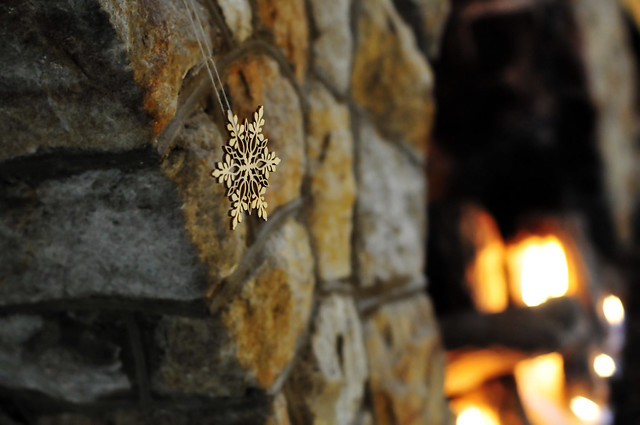
by Christie Purifoy | Dec 19, 2013 | Advent, Food, Music, Uncategorized
People, look east!
The guest is on the way …
A hymn for this, the third Thursday of Advent.
***
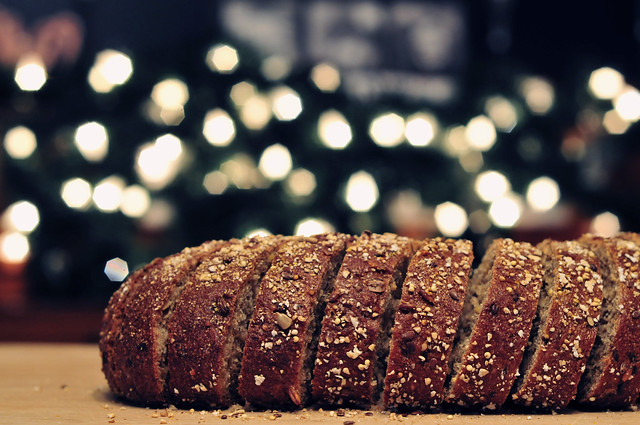
***
“People, Look East”
People, look east. The time is near
Of the crowning of the year.
Make your house fair as you are able,
Trim the hearth and set the table.
People, look east and sing today:
Love, the Guest is on the way.
Furrows, be glad. Though earth is bare,
One more seed is planted there.
Give up your strength the seed to nourish,
That in course the flower may flourish.
People, look east and sing today:
Love, the Rose is on the way.
Birds, though you long have ceased to build,
Guard the nest that must be filled.
Even the hour when wings are frozen
God for fledging time has chosen.
People, look east and sing today:
Love, the bird, is on the way.
Stars, keep the watch. When night is dim,
One more light the bowl shall brim,
Shining beyond the frosty weather,
Bright as the sun and moon together.
People, look east and sing today:
Love, the Star, is on the way.
Angels announce with shouts of mirth,
Him who brings new life to earth.
Set every peak and valley humming
With the word, the Lord is coming
People, look east and sing today:
Love, the Lord, is on the way.
Words: Eleanor Farjeon, 1928
Music: ‘Besançon’, traditional French carol
by Christie Purifoy | Dec 8, 2013 | Advent, Food, prayer, Uncategorized
The word for this second week of Advent is … prepare.
Let the master of the house wash your feet and hands. Let him wrap you in fine clothes.
He has invited us to feast.
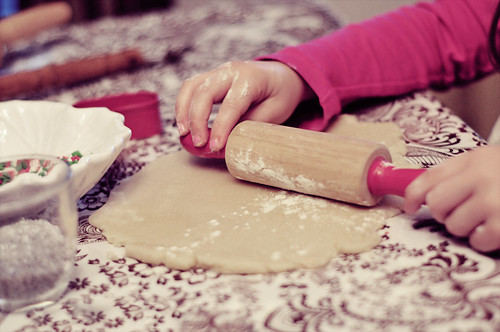
A prayer for the second Sunday of Advent:
Most merciful Lord, your love compels us to come in.
Our hands were unclean, our hearts were unprepared;
we were not fit even to eat the crumbs from under your table.
But you, Lord, are the God of our salvation,
and share your bread with sinners.
So cleanse and feed us with the precious body and blood of your Son,
that he may live in us and we in him;
and that we, with the whole company of Christ,
may sit and eat in your kingdom.
Amen.
(a traditional Anglican prayer)

by Julie Fogliano and illustrated by Erin Stead is a gorgeous, award-winning, treasure of a book. I recommend it for kids and for any big people in your life who love spring or gardening or quietly humorous storytelling.
by Amy Leach is not like anything you have ever read. I promise you that.
. If you enjoyed Barbara Kingsolver’s Animal, Vegetable, Miracle: A Year of Food Life
then I’m sure you will appreciate Bahnson’s own memoir which explores the spiritual dimensions of the same subject (and if you haven’t read Kingsolver’s book please do go and rectify that).
explores a woman’s identity as first a person and an image bearer of a glorious God.








